Nissan Maxima Service and Repair Manual: Intake Manifold Collector
Removal and Installation
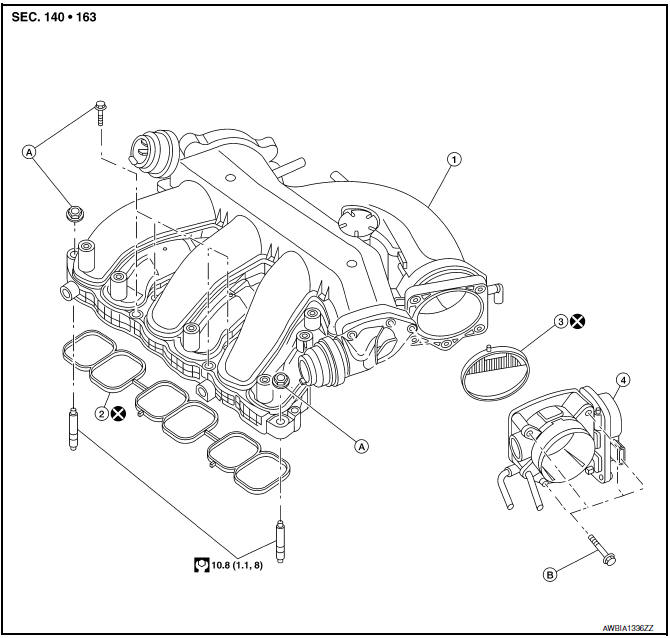
- Intake manifold collector
- Intake manifold collector gasket
- Electric throttle control actuator gasket
- Electric throttle control actuator
- Refer to INSTALLATION
- Refer to INSTALLATION
WARNING: To avoid the danger of being scalded, do not drain the coolant when the engine is hot.
CAUTION: Do not remove power valves.
NOTE: When removing components such as hoses, tubes/lines, etc., cap or plug openings to prevent fluid from spilling.
REMOVAL
- Remove the cowl top, lower cowl top extension and lower cowl top extension brace. Refer to EXT-21, "Removal and Installation".
- Remove the engine room cover. Refer to EM-23, "Removal and Installation".
- Remove front air duct and air duct hose and resonator assembly. Refer to EM-24, "Removal and Installation".
- Remove the electric throttle control actuator bolts in the reverse order as shown and remove the electric throttle control actuator and position aside.
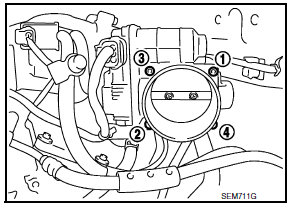
CAUTION:
- Handle carefully to avoid any shock to the electric throttle control actuator.
- Do not disassemble.
- Disconnect the following:
- Power brake booster vacuum hose
- PCV hose
- Electric throttle control actuator electrical connector
- EVAP canister purge hose
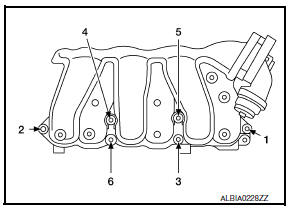
CAUTION: Cover any engine openings to avoid the entry of any foreign material.
- Remove the EVAP canister purge volume solenoid valve bracket bolt. Position the valve aside.
- Loosen the intake manifold collector bolts in the order as shown using power tool, and remove the intake manifold collector and gasket.
- If necessary remove the following components:
- VIAS control solenoid valve
- EVAP canister purge volume control solenoid valve
INSTALLATION
Installation is in the reverse order of removal.
CAUTION: Do not reuse intake manifold collector gasket or electric throttle control actuator gasket.
- Tighten intake manifold collector bolts in the order as shown.
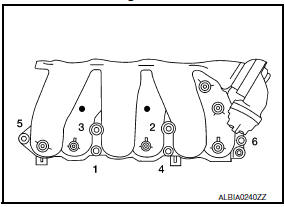
- Tighten electric throttle control actuator bolts in the order shown.
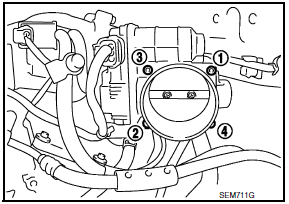
NOTE: After installation, it is necessary to re-calibrate the electric throttle control actuator as follows:
- . Perform the ″Throttle Valve Closed Position Learning″ when harness connector of the electric throttle control actuator is disconnected. Refer to EC-21, "THROTTLE VALVE CLOSED POSITION LEARNING : Special Repair Requirement".
- Perform the ″Idle Air Volume Learning″ when the electric throttle control actuator is replaced. Refer to EC- 21, "IDLE AIR VOLUME LEARNING : Special Repair Requirement".
 Air Cleaner And Air Duct
Air Cleaner And Air Duct
Removal and Installation
Air duct hose and resonator assembly
Front air duct
Air cleaner case (lower)
Grommets
Air cleaner case mounting bracket
Bracket
Air cleaner filter
A ...
 Intake Manifold
Intake Manifold
Removal and Installation
Intake manifold
Intake manifold gaskets
Refer to INSTALLATION
REMOVAL
WARNING: To avoid the danger of being
scalded, do not drain the coolant when th ...
Other materials:
Before starting the engine
Make sure the area around the vehicle is
clear.
Check fluid levels such as engine oil, coolant,
brake fluid, and window washer fluid as
frequently as possible, or at least whenever
you refuel.
Check that all windows and lights are clean.
Visually inspect tires for their appearance
...
Headlights
Replacing the halogen headlight bulb
(if so equipped)
The headlight is a semi-sealed beam type which
uses a replaceable headlight (halogen) bulb.
They can be replaced from inside the engine
compartment without removing the headlight assembly.
If headlight bulb replacement is required, it i ...
C1116 stop lamp SW
Description
The stop lamp switch transmits the stop lamp switch signal (ON/OFF) to the
ABS actuator and electric unit
(control unit).
DTC Logic
DTC DETECTION LOGIC
DTC CONFIRMATION PROCEDURE
1.CHECK SELF-DIAGNOSIS RESULTS
Check the self-diagnosis results.
Diagnosis Procedure
1.CO ...
Nissan Maxima Owners Manual
- Illustrated table of contents
- Safety-Seats, seat belts and supplemental restraint system
- Instruments and controls
- Pre-driving checks and adjustments
- Monitor, climate, audio, phone and voice recognition systems
- Starting and driving
- In case of emergency
- Appearance and care
- Do-it-yourself
- Maintenance and schedules
- Technical and consumer information
Nissan Maxima Service and Repair Manual
0.0067
